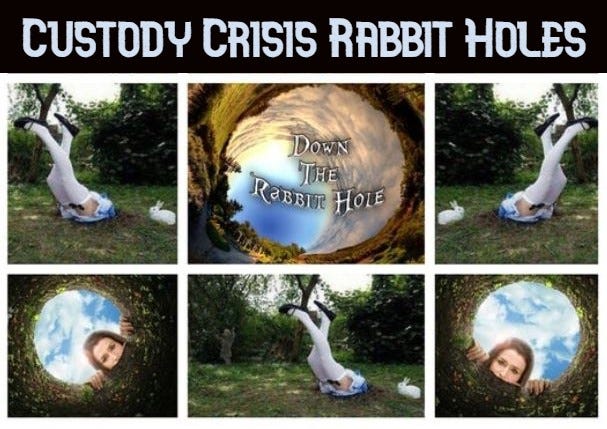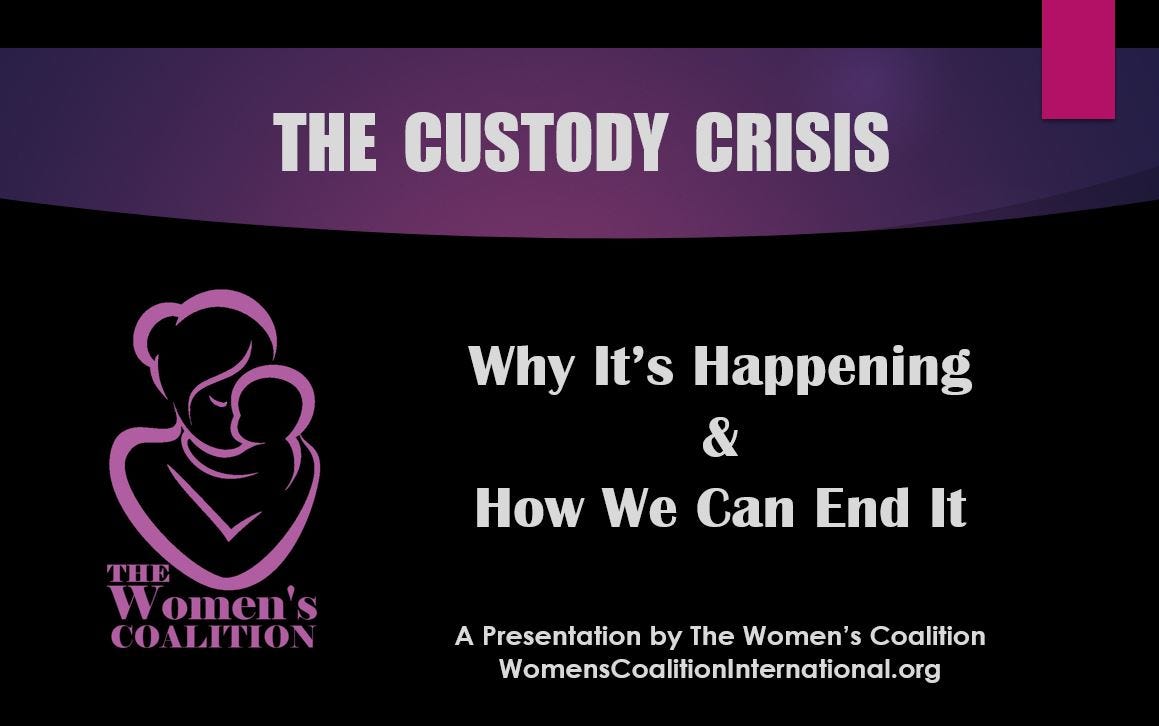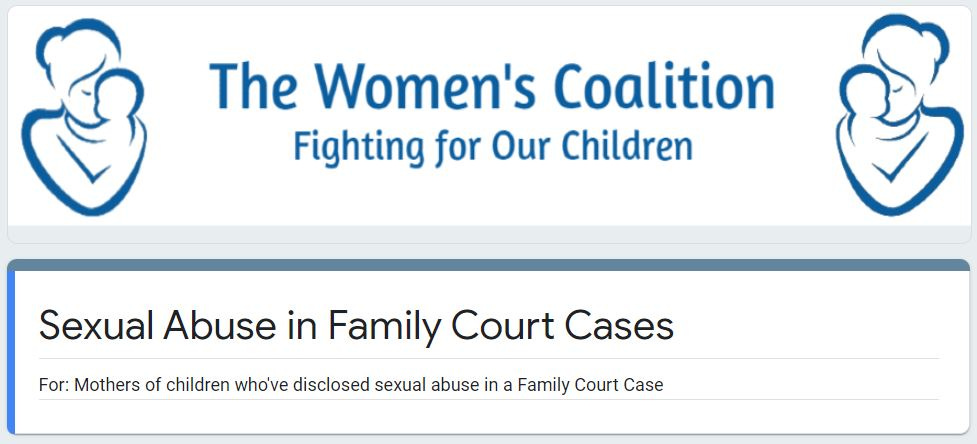First Custody Crisis Case since Women's Lib: Mary Lou 1976
New Series: History of Custody Crisis Cases
The very first documented Custody Crisis case occurred nearly a half century ago in the mid ‘70’s in the American South. Mary Lou* was a wonderful, loving mother to her only child, Alice. Her story begins when Little Alice is just 5 years-old.
Mary Lou’s story will be the first in a series of historical cases profiled in the coming months, in part to pay tribute to these early, brave victims of the crisis, but also to raise awareness about the history of the issue. It is important to be able to put present cases in the context of the first cases to better understand the nature and cause of the crisis.
These historical cases will demonstrate how mothers were losing custody decades before there was a cottage industry, court-appointees were the norm, parental alienation was misused, and other phenomena that sprouted up much later. This should help elucidate the difference between the core cause of the crisis and the symptoms—root vs. branches. This is important because the only way to end the crisis is to resist being diverted into one of the many Custody Crisis Rabbit Holes and instead focus on attacking the root: systemic male entitlement.
THE ‘70’S: WOMEN GAIN POWER
Mary Lou’s story begs the question—why did the epidemic of Custody Crisis cases begin in the 1970’s?
At that time, there was a major shift in family power dynamics caused by women gaining the ability to be financially independent and, with it, the power to divorce abusive or otherwise undesirable husbands. At about the same time many states and countries began enforcing child support giving men a financial reason for wanting custody.
These changing social situations led to an exponential increase in custody battles beginning in the ‘70’s, in which many women were trying to maintain primary custody or protect their children, and many men were trying to maintain control, punish women for leaving, and/or reduce child support. [For an in depth look at the history of the crisis, see “The Custody Crisis: Why It’s Happening & How We Can End It”.]
Mary Lou’s story is told by Louise Armstrong in her seminal book on protective mothers victimized in Family Court: “Rocking the Cradle of Sexual Politics: What Happened When Women Said Incest”. The genesis of the book is custody cases involving sexual abuse, but it extrapolates to all cases with her identification of the crisis as a result of gendered power disparity, i.e. age-old paternal prerogative and entitlement.
Louise refers to herself as “the first walking, talking incest survivor”. She was a pioneer in the incest field, being the first to go public with her story on talk shows and in her book: Kiss Daddy Goodnight: A Speak-Out on Incest. She even led Oprah to speaking out about her own sexual abuse.
During her activism exposing the prevalence of incest, Louise was contacted by thousands of mothers who were unable to protect their children in Family Court. Serendipitously, she was an excellent author and put her talent to use exposing and explaining what would later be referred to as the Custody Crisis.
Importantly, Louise also unmasked the birth of a new era in the cover up of paternal sexual abuse: a shift from blaming the child to blaming the mother. It was becoming more and more difficult to lay blame on children for sexual abuse; and now that women had the means to leave men and fight for custody, this was the next logical step in the agenda to exonerate and enable fathers. This new blame-the-mom strategy has been used in family courts everywhere ever since, taking the form of judges deeming mothers to be some version of “bad or mad”.
WITHOUT FURTHER ADO: Mary Lou’s story as told by Louise Armstrong
MARY LOU’S STORY
From the court documents now before me, we learn that Mary Lou had been divorced from ‘Harry’ in 1975. Custody of the infant child had been granted to Mary Lou with visitation to Harry.
In the winter of 1976, Alice, then five years old, had complained to Mary Lou that Harry had sexually molested her. At once bewildered, perplexed, and alarmed, Mary Lou turned to a local but nationally respected child psychiatrist, ‘Dr. Smith’, as well as to a local clinical psychologist, ‘Dr. Judith Wright’.
Their separate opinions were that Harry had indeed sexually molested the child. And Dr. Smith advised Mary Lou not to allow Harry further visitation (Remember, we are dealing with 1976 here, two years before incest would explode on the human interest pages of newspapers nationwide. Dr. Smith was operating on child-protective common sense.)
The following month, Harry filed in the trial court, seeking to have Mary Lou held in contempt for failure to allow visitation, and seeking custody for himself. Mary Lou’s attorney filed to overrule that motion, appending the evaluations of Dr. Smith and Dr. Wright, and seeking to curtail visitation or at least forbid it to be unsupervised.
The judge, 'Judge Cain’, proceeded to trial, commanding Mary Lou to proceed with proof in support of her motion to terminate visitation.
At the trial of the case some four months later, Judge Cain began by commenting that it was up to Mary Lou to prove reason to terminate visitation, and up to Harry to prove reason for a reversal of custody. No further mention was made at that time of any charge of contempt of court.
The court’s findings and judgment, however, included a specific finding of contempt against Mary Lou: “The petitioner has willfully and continuously violated various orders of this Court without justification and with no showing of mitigating circumstances.”
He explained: “It might be suggested that this time the petitioner has an excuse for at least the denial of visitation, that being a psychiatrist and a psychologist believed the child’s statement of child molesting. The question is not what they believed, hearing only part of the version and not knowing the background or the full factual situation: the question is what the petitioner believed, and … court firmly believed the petitioner … caused the child to make statements, knowing full well the falsity thereof (emphasis mine).
And so we witness here, for the first time I am aware of, the tactical shift from implicating the child (as an accomplice-witness) and thus exonerating the offender, to the focus on the mother as the source of all lies (thus exonerating the offender). With this result for Alice:
"The custody of the minor child may be and is hereby transferred from the petitioner to the respondent, effective immediately, such being in the child’s best interest … The petitioner is found and adjudged to be in contempt of court for her willful, flagrant, and various violations of the orders of the court. As punishment, the petitioner shall be confined to the County Jail for a period of 90 days.”
Could this have been taken, back then, as a premonition of the later backlash against child-protective women? Yes—if we could also have read at the time the impending change in social context, the vigorous efforts to once again silence women, to repeal their so-recently gained rights.
One burr in Judge Cain’s saddle, as it turned out, was that Mary Lou worked at that time for an outspoken feminist and writer, whom the judge referred to as a man-hater with a poor opinion of marriage, and who he said was brainwashing Mary Lou. This southern judge would seem to have been punishing Mary Lou for, in his view, having fallen among persons with seditious ideas.
At Harry’s request, Judge Cain further embellished his decision by restraining Mary Lou from all communication, direct or indirect, with the child Alice—even by use of tape recordings or through third parties.
A great deal of wrangling followed, but the upshot is that Mary Lou has never since heard from or been allowed to communicate with her child (now, of course, no longer a child).
…There’s a whole lot about the sexual abuse/rape. (“My father puts his penis between my legs. My father didn’t say anything. He just did it. I had a Kleenex in my hand and I put it around his penis to keep the sticky stuff from getting on me. I didn’t say anything. My father put his penis between my legs. Then I pulled back when he was pushing inside against what he calls my lips. I pulled my pants back up. He pulled my pants back down. Then he started again…”) But maybe you don’t want to hear all that.
I remember how difficult it was to listen to this, the intensity of knowing that this was a child in the now; the sense of helplessness (which would become a dogged companion later). I remember thinking (hoping) well, this is one case, so far an anomaly, and it’s in the South…
NEXT
Of course, Mary Lou’s case wasn’t an anomaly. It was just the first in an epidemic of Custody Crisis cases in which judges would discredit, silence, and torment mothers with loss of custody.
Watch this space for Elizabeth’s Story, the next in the series. It takes place in the next decade: the 1980’s.
*NOTE: Mary Lou is not the mother’s real name. Louise says the mother was very active and outspoken at the time, but didn’t want her real name being used back then. If the mother sees this article and wants to come forward now and given credit for being the first, please email womenscoalitionintl@gmail.com. If you know who the mother is, please send this article to her.
IN LOVING MEMORY OF LOUISE ARMSTRONG
Louise passed away 15 years ago, but she left us with the best, most creatively written book on the subject. So many mothers are and will be forever grateful to her for illustrating and validating our horrific experiences in Family Court so well.
RIP LOUISE
Louise was also a prolific children’s books author.
LINK TO ALL HER BOOKS ON AMAZON
TAKE THE INTERNATIONAL CUSTODY CRISIS SURVEY to help us document the crisis. [You may remain anonymous.]
TAKE THE SEXUAL ABUSE SURVEY to help us document the cover up of sexual abuse in Family Court. [You may remain anonymous.
You may also support the Coalition’s work through a one-time or recurring contribution through PayPal.









